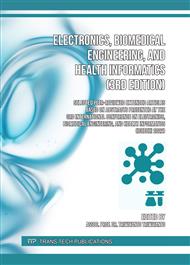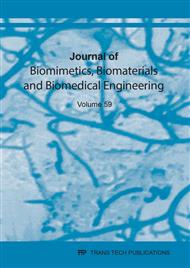[1]
Y. Choi and H. J. Ra: Patient Satisfaction after Total Knee Arthroplasty, Knee Surg Relat Res 2016; 28(1): 1-15 http://dx.doi.org/10.5792/ksrr.2016.28.1.1.
DOI: 10.5792/ksrr.2016.28.1.1
Google Scholar
[2]
O. Robertsson, M. Dunbar, T. Pehrsson, K. Knutson, and L. Lidgren : Patient satisfaction after knee arthroplasty A report on 27 , 372 knees operated on between 1981 and 1995 in Sweden, Acta Orthop Scand 2000; 71 (3): 262–267.
DOI: 10.1080/000164700317411852
Google Scholar
[3]
F. S. Haddad, M. Khan, K. Osman, G. Green : The epidemiology of failure in total knee arthroplasty, Bone Joint J 2016;98-B(1 Suppl A):105–12.
DOI: 10.1302/0301-620x.98b1.36293
Google Scholar
[4]
K. Thiele, C. Perka, G. Matziolis, H. O. Mayr, M. Sostheim, and R. Hube : Current Failure Mechanisms After Knee Arthroplasty Have Changed: Polyethylene Wear Is Less Common in Revision Surgery, J Bone Joint Surg Am. 2015;97:715-20 http://dx.doi.org/10.2106/JBJS.M. 01534.
DOI: 10.2106/jbjs.m.01534
Google Scholar
[5]
M. S. Austin and J. J. Purtill: Revision Total Knee Arthroplasty Infection Incidence and Predictors, Clin Orthop Relat Res (2010) 468:2052–2059 DOI 10.1007/s11999-010-1308-6.
DOI: 10.1007/s11999-010-1308-6
Google Scholar
[6]
K. J. Mulhall, F. Tr, and H. M. Ghomrawi : Current Etiologies and Modes of Failure in Total Knee Arthroplasty Revision, Clinical Orthopaedics and Related Research Number 446, p.45–50 no. 446, 2006,.
DOI: 10.1097/01.blo.0000214421.21712.62
Google Scholar
[7]
B. R. Levine, B. D. Springer, and G. J. Golladay : Arthroplasty Today Highlights of the 2019 American Joint Replacement Registry Annual Report, Arthroplast. Today, vol. 6, no. 4, p.998–1000, 2020,.
DOI: 10.1016/j.artd.2020.09.010
Google Scholar
[8]
J. Argenson, S. Parratte, and G. R. Scuderi : Patient-reported Outcome Correlates With Knee Function After a Single-design Mobile-bearing TKA, Clin Orthop Relat Res (2008) 466:2669–2676 DOI 10.1007/s11999-008-0418-x.
DOI: 10.1007/s11999-008-0418-x
Google Scholar
[9]
S. E. Culliton, D. M. Bryant, T. J. Overend, S. J. Macdonald, and B. M. Chesworth : The Relationship Between Expectations and Satisfaction in Patients Undergoing Primary Total Knee Arthroplasty, J. Arthroplasty, vol. 27, no. 3, p.490–492, 2012,.
DOI: 10.1016/j.arth.2011.10.005
Google Scholar
[10]
S. Matsuda and S. Kawahara : Postoperative Alignment and ROM Affect Patient Satisfaction After TKA, Clin Orthop Relat Res, (2013) 471:127–133, Doi 10.1007/s11999-012-2533-y.
DOI: 10.1007/s11999-012-2533-y
Google Scholar
[11]
J. R. Martin, T. S. Watters, D. L. Levy, J. M. Jennings, and D. A. Dennis : Removing a well- fi xed femoral sleeve during revision total knee arthroplasty, Arthroplast. Today, vol. 2, no. 4, p.171–175, 2016,.
DOI: 10.1016/j.artd.2016.05.005
Google Scholar
[12]
T. Hiranaka, T. Tanaka, K. Okimura, and T. Fujishiro : Manipulation of Tibial Component to Ensure Avoidance of Bearing Separation from the Vertical Wall of Tibial Component in Oxford Unicompartmental Arthroplasty, Clinics in Orthopedic Surgery 2021;13:123-126 https://doi.org/10.4055/cios20277.
DOI: 10.4055/cios20277
Google Scholar
[13]
S.J. Incavo, K. M. Coughlin, and B. D. Beynnon : Femoral Component Sizing in Total Knee Arthroplasty Size Matched Resection Versus Flexion Space Balancing, The Journal of Arthroplasty Vol. 19 No. 4 2004,.
DOI: 10.1016/j.arth.2003.12.071
Google Scholar
[14]
J. B. Stiehl, D. A. Dennis, R. D. Komistek, and P. A. Keblish, Satoshi : In Vivo Healthy Knee Kinematics during Dynamic Full Flexion, BioMed Research International Volume 2013, Article ID 717546, 4 pages http://dx.doi.org/10.1155/2013/717546.
Google Scholar
[15]
D. A. Dennis, R. D. Komistek, S. A. Walker, E. J. Cheal, and J. B. Stiehl : Femoral condylar lift-off in vivo in total knee arthroplasty, J. Bone Jt. Surg. - Ser. B, vol. 83, no. 1, p.33–39, 2001,.
DOI: 10.1302/0301-620x.83b1.0830033
Google Scholar
[16]
M. Taylor, D. S. Barrett, and D. Deffenbaugh : Influence of Loading and Activity on the Primary Stability of Cementless Tibial Trays, Journal of Orthopaedic Research, p.28–30, 2012,.
DOI: 10.1002/jor.22056
Google Scholar
[17]
H. Zhou, A. Liu, D. Wang, X. Zeng, S. Wei, and C. Wang : Kinematics of lower limbs of healthy Chinese people sitting cross-legged, Prosthet. Orthot. Int., vol. 37, no. 5, p.369–374, 2013,.
DOI: 10.1177/0309364612470964
Google Scholar
[18]
M. S. Hefzy, B. P. Kelly, and T. D. V. Cooke : Kinematics of the knee joint in deep flexion: A radiographic assessment, Med. Eng. Phys., vol. 20, no. 4, p.302–307, 1998,.
DOI: 10.1016/s1350-4533(98)00024-1
Google Scholar
[19]
N. Aiman, N. Izmin, F. Hazwani, M. Todo, and A. H. Abdullah : Risk of Bone Fracture in Resurfacing Hip Arthroplasty at Varus and Valgus Implant Placements, International Journal of Technology, vol. 11, no. October, p.1025–1035, 2020,.
DOI: 10.14716/ijtech.v11i5.4312
Google Scholar
[20]
S. P. Garceau, Y. S. Warschawski, A. Tang, E. B. Sanders, R. M. Schwarzkopf, and D. J. Backstein : The Effect of Polyethylene Liner Thickness on Patient Outcomes and Failure After Primary Total Knee Arthroplasty, J. Arthroplasty, vol. 35, no. 8, p.2072–2075, 2020,.
DOI: 10.1016/j.arth.2020.03.017
Google Scholar
[21]
D. A. Crawford, L. Lapsley, J. M. Hurst, M. J. Morris, A. V. L. Jr, and K. R. Berend : Impact of Polyethylene Thickness on Clinical Outcomes and Survivorship in Medial Mobile-Bearing Unicondylar Knee Arthroplasty, J. Arthroplasty, vol. 36, no. 7, p.2440–2444, 2021,.
DOI: 10.1016/j.arth.2021.02.062
Google Scholar
[22]
P. Tzanetis, M. A. Marra, R. Fluit, B. Koopman, and N. Verdonschot : Biomechanical Consequences of Tibial Insert Thickness after Total Knee Arthroplasty : A Musculoskeletal Simulation Study, Appl. Sci. 2021, 11, 2423. https:// doi.org/10.3390/app11052423.
DOI: 10.3390/app11052423
Google Scholar
[23]
N. Kumar, C. Yadav, R. Raj, and S. Yadav : ScienceDirect Fracture of the polyethylene tibial post in a posterior stabilized knee prosthesis : A case report and review of literature, J. Orthop., vol. 12, no. 3, p.160–163, 2015,.
DOI: 10.1016/j.jor.2015.01.002
Google Scholar
[24]
A. Alkheraiji, S. Borai, R. Alfadhil, and F. Aljassir : International Journal of Surgery Case Reports Traumatic fracture of the polyethylene tibial post and cone in a posterior-stabilized total knee arthroplasty : A case report, Int. J. Surg. Case Rep., vol. 97, no. July, p.107437, 2022,.
DOI: 10.1016/j.ijscr.2022.107437
Google Scholar
[25]
J. Triwardono, S. Supriadi, Y. Whulanza, and A. S. Saragih : Evaluation of the Contact Area in Total Knee Arthroplasty Designed for Deep Knee Flexion, International Journal of Technology vol. 12, no. October, p.1312–1322, 2021,.
DOI: 10.14716/ijtech.v12i6.5193
Google Scholar
[26]
J. Triwardono et al. : Finite Element Analysis Contact Stresses on Tibiofemoral Joint and Post Polyethylene Components Used to Evaluated Predesign Knee Implant, Journal of Biomimetics, Biomaterials and Biomedical Engineering vol. 55, p.46–55, 2022, https://doi.org/10.4028/p-uv1qax.
DOI: 10.4028/p-uv1qax
Google Scholar
[27]
M. Ishikawa, S. Kuriyama, H. Ito, and M. Furu : The Knee Kinematic alignment produces near-normal knee motion but increases contact stress after total knee arthroplasty : A case study on a single implant design, Knee, 2015,.
DOI: 10.1016/j.knee.2015.02.019
Google Scholar
[28]
V. Pinskerova, K. M. Samuelson, J. Stammers, K. Maruthainar, A. Sosna, and M. A. R. Freeman : The knee in full flexion: An anatomical study, J. Bone Jt. Surg. - Ser. B, vol. 91, no. 6, p.830–834, 2009,.
DOI: 10.1302/0301-620x.91b6.22319
Google Scholar
[29]
G. Szabò, G. Lovász, T. Kustos, and A. Bener : A prospective comparative analysis of mobility in osteoarthritic knees, J. Bone Joint Surg. Br., vol. 82-B, no. 8, p.1167–1169, 2000,.
DOI: 10.1302/0301-620x.82b8.0821167
Google Scholar
[30]
Y. Kadoya, S. Nakagawa, A. Kobayashi, and K. Takaoka : The flexion gap in normal knees, J. Bone Joint Surg. Br., vol. 86, no. 8, p.1133–1136, 2004,.
DOI: 10.1302/0301-620x.86b8.15246
Google Scholar



